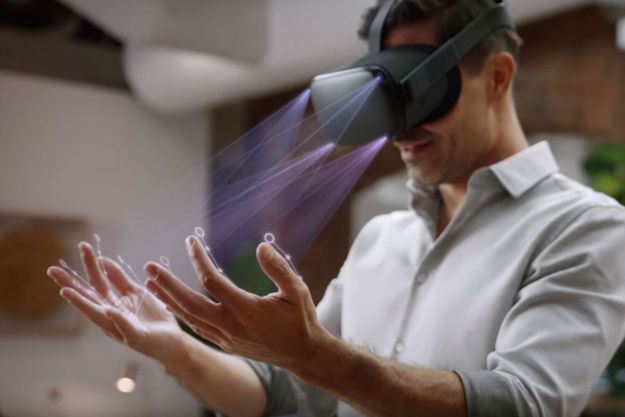Samsung’s GearVR is affordable, intuitive, and immersive — but it’s also limited. The $100 headset is designed to work with a smartphone, and smartphone owners don’t have any external input, be it a gamepad, a keyboard, or mouse. That forces apps to rely on the user’s gaze, and a touchpad on the headset’s flank.
But what if owners didn’t have to rely on such simple control? What if they could access touch controls similar Oculus Touch, or HTC’s Vive? Ximmerse has built exactly that.
Granting this almost magical feature to a headset not originally built for it isn’t easy. To accomplish this feat, Ximmerse has built two devices, the X-Hawk and the X-Cobra. The former is a positional camera that can be placed on the front of a headset, and plugged in through USB. The latter is a pair of sculpted controllers designed to be held vertically. Each has a light bubble, which is tracked by the X-Hawk to discover each X-Cobra controller’s position in 3D space. Each controller also has a rotational tracker.
It’s a system that’s reminiscent of the PlayStation Move, though it operates on a smaller scale, and doesn’t include an RGB light — white’s the only color. Move’s color supposedly made it easier for the Move’s camera to track the controller’s orb, but Ximmerse says its system doesn’t need it, and that the X-Hawk can track the controllers no matter the lighting situation. Given how harsh the lights on the CES show floor are, that claim isn’t hard to believe.
Unfortunately, the Ximmerse system was let down by its demo. Reminiscent of Oculus’ Toybox, the demo placed me in a gray space with a variety of colored blocks and a few more complex objects, like a rubber mallet. The graphics were rudimentary, to say the least, and there wasn’t any interaction aside from picking up objects, releasing them, and knocking them about.
That made it difficult to assess just how well the controllers work. From what I could tell, the position tracking was great. My ghostly hands kept up with the movement of my real mitts. Interacting with objects, though, wasn’t as accurate. I often found myself unable to grasp objects that looked within my reach. Again, it’s hard to say if this was a problem with the controllers, or with the wonky demo.
The Ximmerse system was let down by its demo.
The hardware itself left a similarly mixed impression. I found the controllers comfortable, and while the triggers felt a little light, Ximmerse says the design wasn’t finalized. The camera, on the other hand, was bare electronics — though the case shouldn’t change anything about how it functions.
Ximmerse is also working on another device, called the X-Swift, that’s designed to be worn on a user’s chest. It tracks body movement, so a gamer can lean around cover in a shooter, or move by leaning forward or back. It wasn’t operational at CES, though, so we can’t comment on how well it works.
Interestingly, while the GearVR was used for demos, Ximmerse says it hopes to sell its sensors for a wide variety of headsets. The X-Hawk can connect to any headset with USB input, and its other peripherals are wireless. Users might choose it to augment a Rift, or OSVR, as easily as a GearVR.
Of course, that means software support will be the bottleneck. It’s hard for a small company building add-on devices to gain enough developer goodwill to see widespread adoption. Pricing might help. While not finalized, the company told me the X-Hawk and X-Cobra should cost around $150 together when they arrive sometime mid-year. A price for the X-Swift is TBA.
I came away from Ximmerse impressed that the company had managed to build a motion-control system that’s accurate and hardware agnostic. While I’ve used motion controls for Oculus and Vive, I’ve not encountered one that will work with mobile hardware. It could make headsets lacking native controllers far more immersive, if the company can find a way to get app and game developers on board.
Pros:
- Hardware agnostic
- Accurate tracking
- Affordable
Cons:
- Final hardware remains a mystery
- Lackluster demo software
Editors' Recommendations
- Meta Quest 4: Here’s what we want from the next big VR headset
- Meta wants its next VR headset to replace your laptop
- This futuristic haptic vest should make virtual reality feel more realistic
- Pimax’s 12K QLED VR headset wants to take virtual reality to the next level
- Apple VR headset in the works, AR glasses coming later


